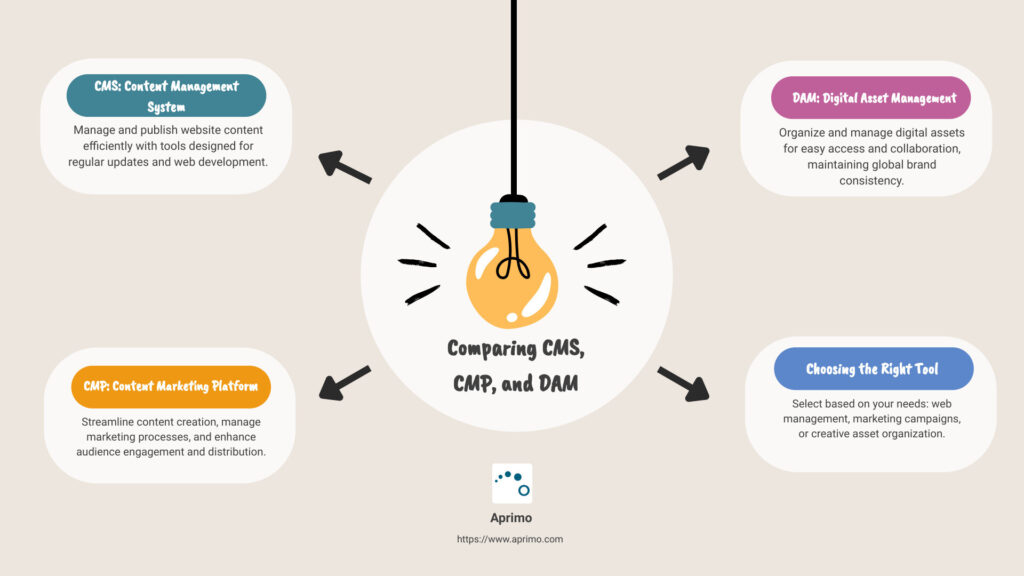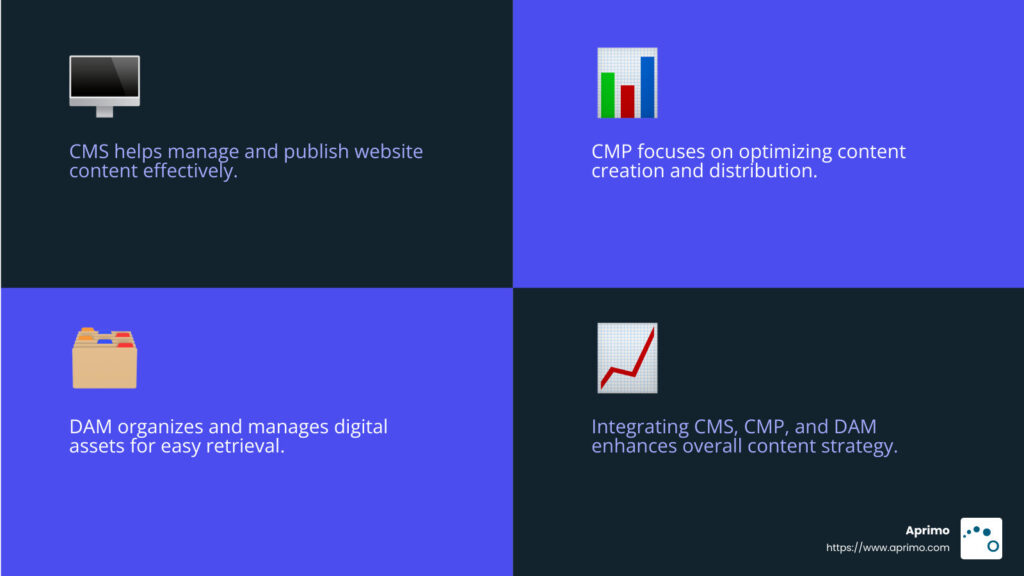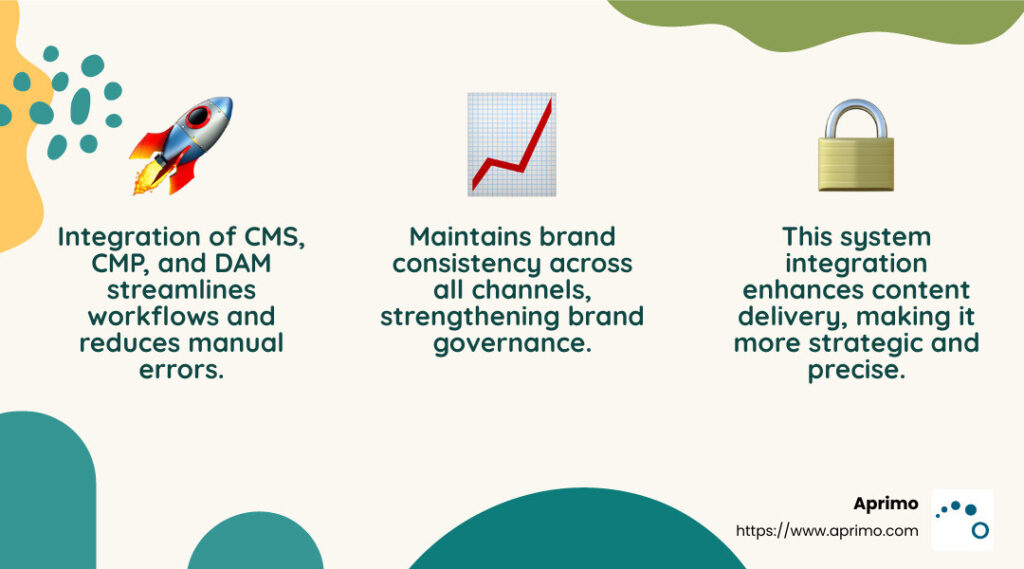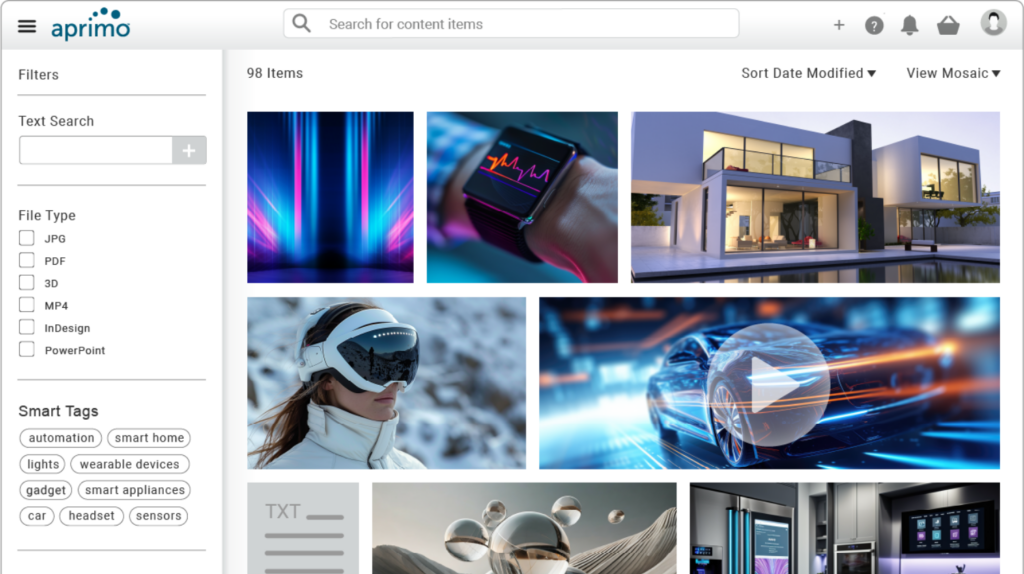Modern organizations are producing more content, and managing that content efficiently has become critical to success. Whether it’s creating engaging websites, launching targeted marketing campaigns, or organizing vast libraries of media assets, businesses need the right tools to handle their content.
Choosing between a Content Management System (CMS), Content Marketing Platform (CMP), or Digital Asset Management (DAM) system can significantly impact how well your content strategy aligns with your business goals. Understanding the distinct purposes and capabilities of each solution is essential for ensuring that your organization is equipped with the best tools for creating, managing, and delivering content effectively.
Understanding CMS, CMP, and DAM
Every savvy marketing operations director knows effective digital communication is crucial to business success. But what’s the right tool for the job?

What is a CMS?
A CMS is a digital toolbox for your website. It lets you create, edit, and publish web content without needing to know how to code. Popular CMS platforms offer user-friendly interfaces, so even staff with no technical skills can manage website content effectively.
Key functionalities of a CMS include:
- Content creation and editing tools
- Publishing workflows and version control
- Template-driven content presentation
- SEO and analytics integration
In short, a CMS is your go-to for maintaining a dynamic, content-rich website.
- Website management: If your primary goal is managing web content (blog posts, web pages), then a CMS is the right solution.
- Ease of use: CMS platforms (e.g., WordPress, Drupal) are often designed for non-technical users, enabling them to manage content without needing extensive coding knowledge.
- Front-end content presentation: CMS platforms handle how content is displayed to users on websites or mobile apps.
What is a CMP?
A CMP focuses on the bigger picture of content strategy. It’s designed to help businesses plan, create, and distribute marketing content across various channels. Think of it as your content campaign manager.
Core functionalities of a CMP include:
- Content calendars and planning tools
- Multi-channel distribution
- Performance analytics
- Collaboration and approval workflows
- Marketing automation integrations
A CMP is ideal for marketers aiming to boost engagement and drive leads through strategic content marketing.
This solution is best for:
- Marketing teams: If your primary goal is to manage, strategize, and distribute content marketing campaigns, a CMP (e.g., Contently, Percolate) is designed for this purpose.
- Multi-channel marketing: CMPs are ideal for managing content across multiple platforms (blogs, social media, email) while keeping the content aligned with marketing goals.
- Content collaboration: CMPs often come with tools to help teams collaborate on content creation, schedule posts, and track performance.
What is a DAM?
Traditionally, DAM systems were all about organizing your digital assets—images, videos, or documents—centrally and making everything easy to find. In recent times, advancements in AI, workflows, and composable architectures have enabled DAM systems to mature into Intelligent Asset Management (IAM) systems that can become core to any brand’s content and campaign tech stack. Whether they’re images, videos, or documents, a DAM system centralizes everything, making it easy to find and use your assets.
Key features of DAM/IAM include:
- Centralized storage of digital assets
- Metadata and tagging for easy search and retrieval
- Version control and asset history
- Rights management and usage tracking
- Integration with other platforms (CMS, CMP, marketing tools)
A DAM is essential for maintaining a cohesive brand image and streamlining content operations across the organization. It’s best for:
- Creative teams: If your team is focused on producing, storing, and retrieving large volumes of media files (e.g., photos, videos), a DAM (e.g., Aprimo) is essential.
- Centralized asset management: DAM systems ensure that teams have easy access to the latest, approved assets and that these assets are consistently used across projects.
- Scalability: DAM platforms are built to store thousands of assets while enabling fast searching, tagging, and categorizing.
- Brand and Marketing teams: If your marketing teams want to expedite the content creation and approval steps of their campaigns, they should deploy a DAM system.
While a CMS focuses on website content, a CMP improves marketing efforts, and a DAM ensures efficient asset management. Each system plays a unique role in your digital strategy, and understanding these differences can help you choose the right tool for your needs.
CMS vs. CMP vs. DAM: Key Differences
When it comes to content management, understanding the differences between a CMS, CMP, and DAM is crucial. Each system serves a unique purpose and offers distinct features that cater to different aspects of managing digital assets and marketing strategies.
Core Features of CMS
The core features of a CMS are designed to help users efficiently create, manage, and publish digital content, especially for websites. Each feature plays a crucial role in content management by streamlining workflows, ensuring consistency, and making it easy for both technical and non-technical users to manage content.
Key features of a CMS include:
- SEO Tools and Optimization: Built-in features help optimize your content for search engines, making it easier for your audience to find you online.
- User Management: Control who can access and edit your website content, ensuring that only authorized personnel make changes.
- Web Content Management: Seamlessly update your website with new text, images, and multimedia content.
How These Features Play a Role in Content Management
- Streamlining Content Production: CMS tools make it easier for teams to create, edit, and publish content with minimal technical barriers.
- Ensuring Consistency and Quality: The use of templates, workflows, and version control ensures that content adheres to branding and quality standards.
- Improving SEO and User Experience: SEO tools, mobile responsiveness, and media management contribute to better search rankings and user engagement.
- Supporting Collaboration and Security: With user roles and permissions, teams can collaborate effectively while maintaining content security and integrity.
A CMS provides the foundation for managing all aspects of digital content, from creation to distribution, ensuring that businesses can deliver engaging, consistent, and optimized content to their audience. A CMS is ideal for businesses focused on maintaining a dynamic online presence with regularly updated content.
Core Features of CMP
A content marketing platform is specifically designed to help businesses plan, create, manage, and distribute content as part of their marketing strategy. The platform brings structure to content marketing efforts by offering tools that enable seamless collaboration, performance tracking, and multi-channel distribution.
Core features of a CMP include:
- Audience Targeting: Tailor your content to reach specific demographics and interests, enhancing audience engagement.
- Analytics: Track performance metrics to understand how your content is performing and make data-driven decisions.
- Distribution Management: Ensure your content is delivered to the right platforms at the right times for maximum impact.
How These Features Play a Role in Content Management
- Strategic Planning: Editorial calendars and collaboration tools ensure that content aligns with marketing goals and that all stakeholders work together efficiently.
- Cross-Channel Distribution: Multi-channel distribution allows marketing teams to maximize content reach and engagement, saving time and ensuring consistency across platforms.
- Performance-Driven Decision Making: Performance analytics and reporting tools help teams assess the effectiveness of their content and make data-driven improvements.
- Streamlining Collaboration: Workflow and approval processes ensure that content creation is efficient and meets quality standards, reducing bottlenecks and enhancing collaboration across teams.
- Resource Management: Asset repositories and campaign tracking tools help teams manage content resources effectively, leading to better use of marketing budgets and materials.
CMPs are designed to streamline the entire content marketing process, from planning and creation to distribution and performance analysis. Their features ensure that content efforts are organized, optimized for engagement, and aligned with the business’s broader marketing objectives. These solutions are essential for marketers looking to drive engagement and generate leads through strategic content marketing efforts.
Core Features of DAM
DAM systems focus on asset management, providing a centralized hub for organizing and accessing digital assets like images, videos, and documents. The goal of a DAM is to create a centralized repository where teams can easily access and share these assets.
Key features of a DAM include:
- AI Tagging: Automatically tag assets with relevant metadata, making it easier to search and retrieve files. Metadata and tagging improve searchability and asset retrieval, enabling users to find specific files quickly based on attributes like file type, date, campaign, or product.
- Brand Consistency: Maintain cohesive branding by ensuring that all team members use the correct, up-to-date assets.
- Collaboration Tools: Facilitate teamwork by allowing multiple users to work on projects simultaneously, streamlining workflows. Collaboration tools streamline the review and approval process, making it easier for creative and marketing teams to work together on projects. These features help ensure that all stakeholders provide input before assets are finalized and distributed.
- Integration with Other Platforms: DAM systems often integrate with other tools such as CMS platforms, marketing automation systems, and project management software. Seamless integration with other platforms allows for streamlined workflows and content distribution. For example, a DAM can feed assets directly into a CMS or marketing automation tool, making it easier to publish and manage assets across multiple platforms.
How These Features Play a Role in Content Management
- Efficiency and Accessibility: Centralized asset storage, combined with robust search and filtering capabilities, ensures that teams can quickly find and access the digital assets they need, reducing bottlenecks in content creation workflows.
- Consistency and Branding: Automated file conversion, version control, and sharing features help ensure that the correct versions of assets are used across different channels, maintaining consistent branding and design.
- Collaboration and Compliance: User roles, collaboration tools, and rights management ensure that content is properly reviewed, approved, and used according to licensing agreements. This reduces the risk of unauthorized content use or legal complications.
- Optimized Asset Usage: Analytics and reporting provide visibility into which assets are most effective, helping teams refine their content strategies and make data-driven decisions about future content production.
A DAM system plays a crucial role in content management by ensuring that digital assets are organized, easily accessible, consistently used, and efficiently shared across teams. This helps organizations manage their content more effectively, save time, and maintain control over the entire asset lifecycle. A DAM is crucial for organizations that need to manage large volumes of digital assets while maintaining brand integrity and operational efficiency.

Benefits of Integrating CMS, CMP, and DAM
Integrating a CMS, CMP, and DAM can revolutionize how your business manages content. Each system plays a unique role, but together they create a powerful synergy that improves efficiency, content delivery, and brand governance.
Workflow Optimization
Integrating these three systems significantly streamlines content workflows by providing a seamless environment for content creation, management, and distribution.
- CMS handles the structure and publication of web content.
- CMP oversees the planning, approval, and distribution of marketing content across channels.
- DAM acts as a central repository for all digital assets, ensuring that teams can access approved images, videos, and documents directly within their workflows.
This integration eliminates the need for switching between platforms, speeding up the content creation process and ensuring that the latest assets are consistently used. Together, they eliminate redundant tasks and reduce manual errors, allowing teams to work faster and more efficiently. This means quicker time-to-market for campaigns and more time spent on creativity rather than logistics.
Improved Content Delivery
Integrating a CMS, CMP, and DAM improves content delivery by ensuring seamless access to assets and content across all channels.
- CMS manages how content is structured and published on websites.
- CMP orchestrates multi-channel content distribution, ensuring that content reaches the right audience at the right time.
- DAM provides quick access to the latest digital assets, ensuring consistency and quality while reducing delays.
This integrated workflow allows for faster, more efficient content production and distribution, ultimately speeding up time-to-market for campaigns and web content. The combined power of these systems ensures that your message reaches your audience effectively, whether through a blog post, social media campaign, or email newsletter. This integrated approach improves the overall customer experience, making your brand more engaging and memorable.
Strengthened Brand Governance
Integrating a CMS, CMP, and DAM strengthens brand governance by ensuring that all content and assets are consistently aligned with brand standards across multiple channels.
- DAM centralizes the storage of approved digital assets, such as logos, images, and videos, allowing teams to easily access the latest, brand-compliant materials.
- CMP oversees the strategic distribution of marketing content, maintaining consistency in tone, messaging, and visuals.
- CMS ensures that this branded content is displayed uniformly across websites and digital platforms.
This integration streamlines the enforcement of brand guidelines, reduces the risk of outdated or off-brand content being used, and ensures that every piece of content accurately and cohesively reflects the company’s identity. With these systems working together, you can confidently uphold your brand’s identity, ensuring that every piece of content resonates with your core values and message. This alignment strengthens brand loyalty and trust among your audience.

Get the Right Type of Content Management for All of Your Organization’s Digital Assets
Managing content effectively is crucial for any organization. The right tools can make all the difference in how you handle the content lifecycle, from creation to distribution and beyond.
AI-powered solutions are revolutionizing the way we manage content. By leveraging advanced AI technologies, DAM platforms can automate tasks, improve asset findability, and ensure brand governance. AI helps streamline processes, making it easier to organize, find, and share digital assets.
The integration of CMS, CMP, and DAM creates a cohesive ecosystem that maximizes workflow efficiency and ensures brand consistency. By aligning these tools with your business goals, you can deliver a seamless and engaging customer experience.
Aprimo integrates DAM and CMP capabilities as part of its platform. These capabilities have been recognized as the industry leader by all major analyst firms. Aprimo is built on a composable architecture, making it easy to integrate with any CMS platform as well.With Aprimo’s powerful tools, teams can streamline workflows, ensure brand consistency, and efficiently distribute content across all channels, all while having centralized access to approved assets. This integration optimizes collaboration and accelerates content delivery, making it easier to scale your marketing efforts. To experience the full potential of Aprimo and see how it can revolutionize your content management, book a demo today and explore how it can elevate your content strategy.


